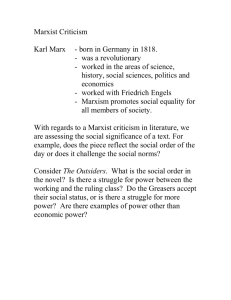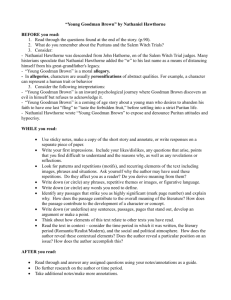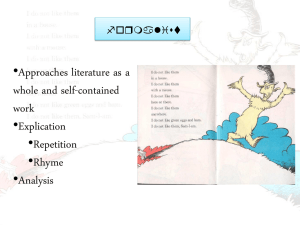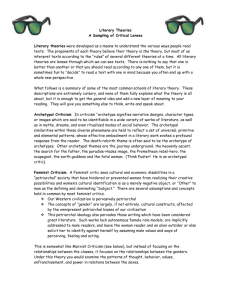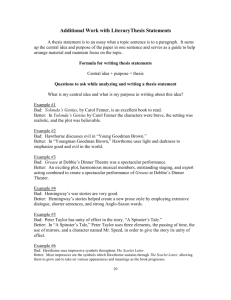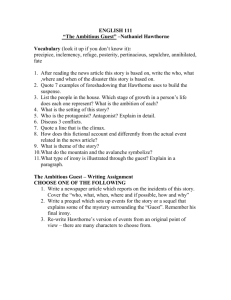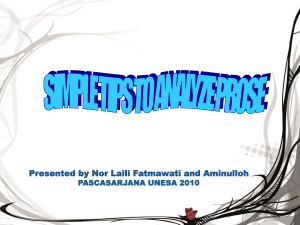Art&TimesShortStory
advertisement
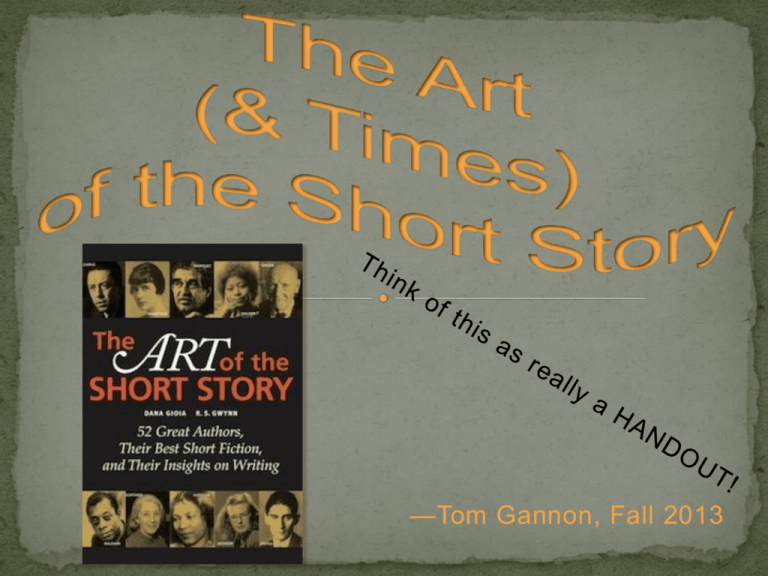
—Tom Gannon, Fall 2013 Introduction • "The short story is fiction's sharpest axe, its most intense imaginative tool for breaking up the frozen seas of our individual isolation" (Gioia & Gwynn 5). • FICTION GENRES—a continuum: Short Story <—> Novella <—> Novel Poe’s classic definition is that a SHORT STORY should be able to be read in a “single sitting.” Longer short stories (which break this rule), such as Kakfa’s “The Metamorphosis” & Tolstoy’s “The Death of Ivan Ilych,” are often referred to as NOVELLAs—which, themselves, aren’t quite long enough to qualify as (book-length) NOVELs. Literary Periods • As a quite recent genre that didn’t develop until the early 1800’s—in the U.S., for example, with Irving, Hawthorne, & Poe—the short story can be usefully categorized into four distinct literary periods: 1) ROMANTICISM: roughly the 1st half of the 19th century; examples: Hawthorne, Melville, Poe; often characterized by high emotionalism & sentimentalism, fanciful PLOT lines, supernatural elements, & exotic SETTINGs 2) REALISM: approx. the 2nd half of the 19th c.; examples: Chekhov, Crane, Dickens, Dostoevsky, Flaubert, Tolstoy; characterized by realistic CHARACTERs, PLOTs, & SETTINGs (literature as a “mirror carried along the road” or a “slice of life”) 3) MODERNISM: roughly the 1st half of the 20th c.; examples: Cather, Faulkner, Hemingway, Joyce, Kafka, Woolf; characterized by both (continued) realism and often an experimentalism in STYLE; also, a new emphasis on the main CHARACTER’s (“quieter”) epiphany often replaces the older emphasis on an action-packed PLOT 4) POSTMODERNISM: approx. the 2nd half of the 20th c. (through today); examples: Alexie, Atwood, Barthelme, Carver, Borges, Nabokov, Pynchon; often characterized by even greater experimentation, especially via POINT OF VIEW shifts, absurd CHARACTERization, and “openended” PLOT lines (or no discernable plot at all) Some Crucial Terminology • UNIFIED EFFECT: Edgar Allan Poe’s famous term for his aesthetic tenet that every word, image, sentence, et al. in a story should be “doing something,” working towards making the text’s plot, characters, & style an “organic whole” (G&G 5, 725). By the way, organic metaphors played a major role in Poe’s own Romantic age; and this “organic whole” idea then became an important principle of 20th c. formalism—that is, the New Criticism. • EPIPHANY: James Joyce’s famous term for the main character’s sudden moment of (self-)realization, a spark of illumination, often towards the story’s end (G&G 5-6, 464). Indeed, in many of the stories of Joyce’s Dubliners, this often almost imperceptible character change serves as the story’s entire DÉNOUEMENT (plot resolution)—leaving the less careful reader to wonder, “Huh? What the hell happened here?!” More generally speaking, that the main character undergoes a CHANGE, often via a concluding moment of self-recognition, has been a hallmark of the short story, especially during the Modernist period. FORMALIST ELEMENTS • PLOT (G&G 849-854)—the chronological arrangement of a story’s events, classically diagrammed as o rising action (development, exposition) o climax (crisis, point of greatest tension) o dénouement (resolution) —Note that some modern—and many postmodern— short stories have no dénouement (or climax) to speak of (that is, they are “open-ended”). Indeed, as G&G put it, some stories have "no real plot or chronology" (851). • Other common PLOT terms: o flashback o foreshadowing o scene (episode) vs. narrative summary o O. Henry ending • CHARACTERIZATION (G&G 854-857) o protagonist / antagonist • anti-hero o round character (developed, individualized)— —versus— o flat character • stock character (stereotype) o dynamic character / static character • conflict • epiphany —One could finally add (again) that character becomes more important, generally speaking, than plot in modern & postmodern short stories, but of course there are a great many exceptions. • POINT OF VIEW (G&G 857-858) o 1st Person (narrator) • major character • minor character ("narrator-agent") —also: naïve narrator; reliable vs. unreliable ~; stream of consciousness o 3rd Person (narrator) • omniscient "Olympian" (editorial-intrusive, authorial-intrusive) • limited omniscient ("central intelligence") multiple character limited omniscient • objective-detached ("camera eye," "fly on the wall") • SETTING (G&G 859-860) o atmosphere (“emotional aura” [859], mood) o local color / regionalism —G&G’s most interesting/useful point regarding setting is that it can work metaphorically, as a trope (yep, as a—shudder—“symbol”!): e.g., the deep woods (“dark wilderness”) in “Young Goodman Brown.” Most fascinating are certain settings that may be said to act as actual & active “characters.” • THEME (G&G 860-861) I try never to use this word since it is more often abused than usefully employed. For one thing, reducing a work of art to a sentence-or-two summary is a travesty of a mistranslation, what the New Critics call the “heresy of paraphrase.” Secondly, works that can be easily reduced into such a “message” are didactic (preachy, moralistic). As G&G tell us, “[m]odern stories can seem[!] extremely reticent in revealing their themes.” And good for them, I say. To quote from an old handout of mine: “Is the theme preachily DIDACTIC? or more subtly expressive of human experience in all its chaotic contradictoriness?” In sum, “theme-hunting” is a fairly fruitless enterprise, unless you want to reduce a work of art to clichéd generalities. • STYLE (G&G 861-862) o diction (word choices; incl. formal vs. vernacular) • imagery (concrete ~) o sentence structure/rhythm: Recall the famous contrast between Hemingway’s short, minimalist sentences and Faulkner’s long roller-coaster rides of syntax. o figurative language: An author’s figures of speech are often one of the most interesting technical devices to analyze, as major clues to the author’s tone (attitude). Metaphors that are central to a story's meaning used to be called "symbols"; however, this term has fallen out of fashion, in part because "symbol-hunting" has been abused as much as "theme-hunting." • TONE (G&G 862) Think “tone of voice,” which is ultimately revealing of the author’s attitude towards his/her subject matter. It must be derived indirectly, usually, via the author’s diction, figures of speech, etc. One can also often distinguish between the 1st-person narrator’s (more obvious) tone of voice and the author’s implied attitude regarding the story’s characters & events . . . creating a level of IRONY. • IRONY o plot/situational irony: Do things turn out differently than expected? Are there any REVERSALS of fate or fortune? o dramatic irony: Do WE know something the characters DON'T? (think dramas, as in plays) o verbal irony: saying one thing, meaning another, often the opposite (think sarcasm; understatement; hyperbole) CRITICAL APPROACHES • FORMALISM (aka New Criticism) (G&G 879): A formalist approach to the short story is simply an analysis via the terms we have just explored, a demonstration of how, for instance, point of view, figures of speech, irony, foreshadowing, etc., work together to create an organic whole (Poe’s “unified effect”). Let’s take Hawthorne’s “Young Goodman Brown”: one could point out how the foreshadowing, the irony of the story’s names & situations, the very setting—etc.!—all lead to an effective narrative presentation of the title character’s crisis of spirit and to the story’s striking & peculiar(?!) dénouement. For instance, the story’s last word is “gloom” (“YGB” 357). Significantly, this word not only encapsulates Brown’s own character change—his disillusionment—but it is prepared for by the story’s haunting night-woods setting & atmosphere. Dramatic irony also lies heavy upon this tale, as the reader is constantly “getting it” (perceiving YGB’s fall into damnation) before the main character himself does. Verbal irony then drives the nail further in: “Well, I still got FAITH,” he reassures himself at several points. Yeah, right, felluh! Well, what about the general “theme,” then, or rather—the main unified effect? New Critics in particular were especially interested in tensions, ambiguities, ironies, oppositions, & paradoxes, and so tended to see the overall text as a “reconciliation of opposites.” Whatever the “theme” of “Young Goodman Brown” is, it certainly involves the opposition of “good” vs. “evil”; but is this opposition a mortal combat? Or a close interrelationship?! The New Critic might state his/her own “thematic” view of the matter, and argue (again) how all the “smaller” technical devices work towards that “reconciliation.” (However: you don’t have to buy into this “oppositional” stuff to do good FORMAList criticism; you need only show how the parts support the whole.) • BIOGRAPHICAL CRITICISM (G&G 881-882): By definition, this approach applies our knowledge of the author in explicating the short story. What in the author’s recorded life clarifies the details of the text? How does Hawthorne’s religious background or marital experience, for instance, help us understand “Young Goodman Brown”? How about his personal attitude towards the Salem witch trials? (See the footnote regarding Hawthorne’s greatgrandfather [350].) Note that this approach is deemed pretty oldfashioned, and even dangerous. An author’s elsewhere-expressed ideas about what his/her story “means,” especially, should always be taken with a grain of salt. (But: the G&G anthology! . . .) • (Old) HISTORICAL CRITICISM (G&G 884885): Related to biographical criticism (and just as long in the tooth), this approach examines the author’s socio-historical milieu (his/her time & place) to help explicate the text. The merits of this approach are most obvious, of course, in the interpretation of centuries-old texts, such as those by Shakespeare and the Greek dramatists. “Young Goodman Brown” may be a special case here, in that research into early Puritanism (and the witchcraft trials of the 1690’s) might be just as useful as exploring the historical context of Hawthorne’s own ante-bellum 1830’s. • PSYCHOANALYTIC CRITICISM (G&G 887888): To do this well, read Freud and Lacan or at least a lot about them, so you can throw around terms like id/ego/superego and the imaginary/symbolic/real with skillful abandon. (Translation: I won’t be able to tell you how to do it in a PPT slide or two.) Psych crit is a versatile tool that has been “interestingly” applied to the author (“Did Shakespeare have an unresolved Oedipal complex?”), to a text’s characters (“Does Fortunato’s cap with bells make him a walking phallic symbol?!”), and to readers themselves. Freudian readings often strike one as more “intriguing” (even shocking) than usefully revealing of and relevant to a text; but at least they’re rarely boring. In “Young Goodman Brown,” the psychoanalytic critic would likely point immediately to the staff/serpent—that “writhing stick” (351)—as not just a metonym for Satan, but as a pretty obvious phallic signifier. But then, what does sex have to do with this story? Well, in one sense, a lot. Indeed, Hawthorne seems to anticipate Freudian theory in presenting humans, at their core and essence, as “instinctual” (and sexual and therefore “sinning” & “evil”) beings. Freud would later agree that this is our “nature and destiny” (355). • Then there is the intrapsychic method, in which the story’s characters are read as different aspects of Freud’s tripartite model of the psyche. The main character is usually the ego, while two other important characters fulfill the roles of the superego & id, as in my bad cartoon above. See also G&G 888-889 for a well-done (even convincing) Freudian reading of Poe’s “The Tell-Tale Heart.” • MYTHIC (aka Archetypal) CRITICISM (G&G 890): This approach, at its best, requires some knowledge of Jungian (archetypal) psychology. Archetypes are functions/forms of the collective unconscious, figures & processes that supposedly recur throughout human discourse, from ancient myths to yesterday’s Facebook meme. The major archetypal figures are the shadow, the anima/animus, the wise old man/wise old woman, and the unconscious Self (often represented by an image of wholeness). Major archetypal processes include the (hero’s) journey (often as a descent & return), the divine marriage, and death/rebirth. Crucially, the intrapsychic approach is even more characteristic of Jungian interpretation than it is of the Freudian. Indeed, the common archetypal reading is pretty formulaic: the main character (as ego) goes on a journey, encountering the shadow, anima (or animus for the female ego), etc., on his/her way to a reunion w/ the unconscious Self—returning a new/changed (“reborn”) ego. (Joseph Campbell’s “hero’s journey”—often a descent and return—is merely an updated version of this classic formula.) Thus the other main characters are read as archetypal aspects of a single psyche, and the main plot events = outer manifestations of the inner journey. “Young Goodman Brown” can easily be read (at least at first) as the ego’s inner journey into the depths of the unconscious. The dark, satanic figure YGB first encounters would then be the shadow—and “Faith,” his anima? . . . However, this is no “redemptive” journey, since it is hardly leads to a redemptive “rebirth” of egohood. Rather, it’s an inverted/negative one, for the result is disillusionment & “gloom.” The orthodox Jungian critic would likely end up reading the story as a failed attempt at ego individuation (“growth”); in some ways, the ego (YGB) never really returns, as it were, but remains “lost in the deep woods”—and perhaps madness. • READER-RESPONSE CRITICISM (G&G 897898): In the communication chain of author<-> text<->reader, this approach was revolutionary in giving at least equal weight to the reader, who thus becomes an active agent in (half-)”creating” the “text.” But one immediate caveat: R.-R. does NOT = “I think ‘YGB’ is a bad work of art because I’m afraid of snakes. And the dark.” It CAN be a self-analysis of your chrono-logical experience/process of reading a text, as you continually guess what’s going to happen next, continually filling in textual “gaps” and continually revising your “horizons of expectation.” (Halfway through “YGB,” for instance, how did you think it was going to end? Why?) However, I think R.-R. is more valuable when applied to GROUPS of readers—e.g., why do young (or old) male (or female) readers commonly respond to this specific story (or even genre) in such a positive (or negative) way? A particularly interesting version of this is a subset of R.-R. called reception theory, which analyzes how people of different eras have responded to a text; the argument here is that Shakespeare’s Romeo & Juliet was really a (very) different “text” when viewed by its contemporary audience, compared to the “text” half-”created” by a 21st-c. audience. Vis-à-vis “YGB,” 180 years of changes in mainstream U.S. religious beliefs has likely radically altered how “YGB” is read today, compared to its initial 1830’s reception. One final R.-R. concept deserves treatment even in so brief a summary, Stanley Fish’s “interpretive community.” Considered one of the most radical R.-R. scholars, Fish finally responded to his critics with a “Not to worry”: even the most idiosyncratic readings (like Fish’s!) are immediately “disciplined” when shared with a group of readers (in a classroom setting, usually); ultimately, some “common-sense” consensus is arrived at, and the unacceptable interpretations are weeded out. (This is actually kind of sinister, since it ends up supporting the same old status-quo readings based upon the same old & boring critics & teaching guides.) But the gist is—if you think Frost’s “Stopping by Woods” is about Santa Claus, prepare to be chastened & subdued by your interpretive community. Finally, note also G&G’s comment regarding “YGB,” under “Historical Criticism”: critics “might also explore the probable associations a nineteenth-century New England reader would have made with certain images and events, especially in regard to the religious and sacrilegious elements of Hawthorne’s theological horror story” (884). This is really reader-response criticism at work—more specifically, reception theory. • MARXIST CRITICISM (G&G 893, 901-902): The first overtly political literary theory, Marxist criticism approaches literature via the lens of socio-economics, that is, class. Marxism explicitly critiques the inequities of a class-based capitalistic system in which the capitalists/bourgeoisie exploit the labor of the proletariat (lower/working class). Although “YBG” is set in pre-industrial/capitalist times, a definite class hierarchy is certainly referenced in the story. “Goodman” and “Goody” are addresses for the “common” folk, after all, for the Everyday Joes & Janes of Puritan society, in contrast to the obviously more well-to-do political and church leaders alluded to. With Hawthorne’s story, however, the Marxist critic would likely concentrate on another aspect of Marxist theory, the concepts of ideology and false consciousness. Social belief systems (ideologies) accepted blindly by the masses from birth—and ergo living in false consciousness—keep the capitalistic system running smoothly; and one of the most powerful ideologies in this regard is religion (the “opiate of the masses”)—in this case, Puritanism. The bottom line, in the Marxist view: it’s easier to get workers to accept a miserable, slave-like existence in this world when there are promises of a better life in the next one. (“Just be good—and a good subject.”) However, the Marxist critic would have to deal with the problem that religious ideology doesn’t seem to be functioning that well in this story, since apparently everyone has “gone to the devil” anyway?! Another tack, then, might be to read YGB’s disillusionment as a positive seeing through the dominant coercive ideology; but that seems like an anachronistic tough sell. At last, “YGB” probably isn’t the greatest text for the Marxist critic to attack. See another of our early readings, Gogol’s “The Overcoat,” for a much more obvious target. See also G&G 893-895 for a welldone Marxist reading of D.H. Lawrence. • STRUCTURALISM is another approach too complicated to explain in a slide or two, so let me just point to one common methodology. Structuralism originated in 20th-c. linguistics, and the then-radical theory that meaning is created by difference, especially through binary oppositions. The structuralist thus might point out the various binaries at work in a text: these are key sets of signifiers by which meaning is created. Key to structuralism is that it identifies how a text means, not what it means. Indeed, “what” it means can usually be reduced to formulistic clichés inevitably borrowed from other texts, or—more rightly put—from the general system of codes/signifiers forever at work in a society’s discourse (≈intertextuality). Looking at “YGB,” one is immediately impressed by several binaries at work that “create meaning.” Besides the general theological issue of “Good”/”Evil” (structural binaries are often expressed as fractions), we have an imagistic motif, working throughout the story, of Light/Darkness. And this is structurally fitting, since Western culture (at least) has long associated “good” with the “light” and “evil” with the “dark.” You may have recognized that this structuralist technique isn’t that different from New Criticism’s search for “oppositions” & “paradoxes.” Structuralism is really the major Euro- brand of FORMALISM, with different terminology and a (more “scientific”) emphasis on linguistics. • DECONSTRUCTION (G&G 899-900): In the 1960’s, some structuralists rebelled against their own precept that language/discourse is a finely tuned closed system that works completely well in imparting “meaning”: ergo poststructuralism, and its most famous methodology, deconstruction. Poststructuralists—the key figure here is, of course, Derrida—insist instead that all texts are “open,” multivalent in meaning, claiming at last that “meaning” itself is forever escaping down the signifier chain, and that the binaries themselves aren’t even fully “opposite,” but rather depend upon each other for their meaning. Thus, in the man/woman binary, “man” actually requires (its opposition to) “woman” as part of its very definition, and vice-versa. One key deconstructive technique is known as reversing the binary. For instance, in a heavily patriarchal text in which women are obviously cast as the inferior of the sexes, deconstruction might ask, “What if we read the text from the point of view of the inferior part of the binary fraction (man/woman)”? This would likely result in a very different reading, and thus “meaning,” for the story at hand. One could thus return to “YGB” and—first, like a good structuralist, identify the key binaries of good/evil & light/dark. Now, assuming that a “normal” reading is that “good” & “light” are the human ideal, and that YGB has somehow been psychologically blighted, what if one privileged the “evil” and the “dark”? What if YGB’s final attitude is actually the true one, that human life is ultimately one of “evil,” hypocrisy, darkness, and gloom—and that “Satan” (as it were) really is the true ruler of the world & cosmos? (Wow.) A final key concept of deconstruction is undecidability. The critic does not simply insist upon his/her “reverse” reading, but rather puts everything in doubt: sure, the dominant (“normal/good”) reading is still possible, and this inverted reading is now possible, and . . . so the text (like all texts) is at last “undecidable.” (A final note: “YGB” specifically calls for LOTS of doubt on the part of the reader—even explicitly asking, “Was it a dream? Or not?!”—making the deconstructionist’s task all the easier.) • GENDER CRITICISM (incl. Feminism, Queer Theory) (G&G 895): There are so many (often competing) philosophies of FEMINISM now that I will just summarize some of its most characteristic lit-crit moves: 1) critique representations of women in patriarchal (male-dominated) literature; and 2) recuperate & champion past (& inevitably suppressed) women’s writing. Move #1 can certainly be applied to “Young Goodman Brown” and its representation of women. The main(?!) female characters—Faith and the two older “Goody” women—are pretty much hangers-on without selfagency; and Faith in particular becomes merely her name, at last, an allegorical signifier whose religious meaning becomes painfully ironic in its mantric See also G&G 896-897 for a well-done feminist reading of Charlotte Perkins Gilman’s now-wellknown “The Yellow Wallpaper.” Both author and story, by the way, were recuperations (“re-discoveries”) by the 1st wave of literary feminist criticism. • NEW HISTORICISM is also impossible to explain in a paragraph or two, but I’ll try. Denying older historicists’ faith that there is one true history, New Historicists claim that all history is subjective and biased. In fact, all texts are made up of many “histories”—or narratives, or discourses— and these discourses are usually “competing” on an ideological battlefield, as it were. A second key concept (taken from Nietzsche & Foucault) is power. Each society in each moment in time consists of a set of discourses of power that keep society functioning by coercively controlling the people. (Think capitalism, the sciences, organized religion, heterosexism, etc.) However—and this is where the “competition” comes in—there are also subversive or “submerged” discourses or “voices” that are in constant competition with the dominant discourses. Now the cool thing: many more than one discourse (or “voice”) exists in every text, usually including both discourses of coercion (or containment) and subversion (or rebellion). New Historicism also has a specific methodology that calls for analyzing a text—or really the historical era in which it was written—by analyzing a whole lot of other contemporary “texts”—be they letters, pop advertisements, graffiti, public ceremonies, YouTube vids—the works. (Note that New Historicism developed from poststructuralism, for which everything is a “text.”) The New Historicist would likely not even consider that he/she was analyzing “Young Goodman Brown” per se; the story would just be a starting point that might journey through Hawthorne’s letters, the use of the word “powwow” in the 1830’s, Hawthorne’s wife’s magazine reading, etc., etc. Characteristically, the critic would ultimately unearth several 1830’s discourses that underlie the story—and at least one of them will be surprising! Invariably, these discourses are found to be discordant, in competition with each other. One possible direction would be to discover a long-submerged discourse of actually admiring witchcraft in Hawthorne’s day—at great odds, obviously, with the tale’s main “good Christian” discourse of power. • POSTCOLONIAL CRITICISM/CRITICAL RACE THEORY: Postcolonial criticism focuses not only on native writing from past (& present) Eurocolonized cultures, but on how the non-Western colonized have been represented in the dominant (colonizer) literature. Critical “race“ theory is a related approach because most of the colonized were/are people of color, and even U.S. AfricanAmericans & Native Americans have very much been the victims of colonialism. Through these lens, “Young Goodman Brown” doesn’t come off well, in its glib demonization of the local Native Americans. Indians are “devilish,” prone to beast-like yelling, and their own religious practices are assumed to be as satanic as the story’s Black Mass (351, 353, 355). (I call this racism.) • ECOCRITICISM: As its prefix indicates, ecocriticism is invested in how “Nature”—the environment—is represented in a text, and ultimately whether the text offers a vision of good ecology. As a practicing ecocritic myself, I can’t read “Young Goodman Brown” without lamenting how the forest (and therefore “nature”) is characterized as a “wild” and bestial—even demonic & evil—”heathen wilderness” (353) bereft of the blessings of good Christian civilization (and wood-chopping!). (Indeed, this was a common response to the American environment by early Euro-colonizers.) Other species in the tale are mostly “howling . . . beasts” (353) associated with Satan & evil—epitomized by the serpent wrapped completely in theological metaphor. Appendix: “It’s a Symbol!” I should probably clarify my several slams of the terms “symbolism” & “symbol.” The crux of the matter is that these are terms from the (old-school) New Critics, who thought the symbol was a special, “deeper” figure of speech, in some different “mystical” realm (as it were) from the common metaphor. Then structural linguistics came along, which (more “scientifically”) determined that, no, a metaphor is a metaphor (or, to use their usual term), a trope is a trope—no matter how “deep” & important to a story it seems to be. In sum, in today’s critical parlance, the terminology of structuralism has won the day over New Criticism. In fact, I would encourage those of you who are inveterate symbol-hunters to shift your enthusiasm to the textual pursuit of binaries. As you may have garnered even from my brief survey of critical approaches, identifying binaries is not only a central structuralist strategy, but it can also be used in deriving the “paradoxes” & “oppositions” of New Critical formalism, and it is also the usual first step of deconstruction. Moreover, ALL the more recent “political” critical theories are based upon one or two central binaries (e.g., rich/poor, male/female, coercion/subversion, colonizer/colonized, white/nonwhite, humankind/”nature”).
